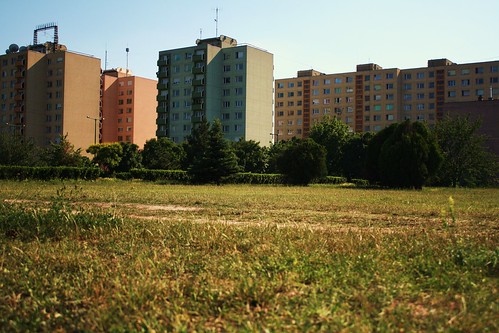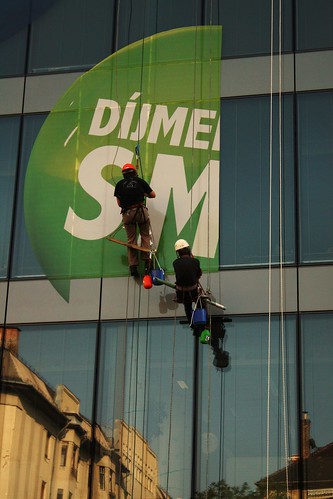
Some weeks ago, I took the train to Dunaújvaros (that's Danube New Town, formerly Sztálinváros) the purpose-built industrial town some way down the Danube in central Hungary. Under Soviet rule, Dunaújvaros was used to showcase the socialist perfectibility of Hungary, even after the 1956 Hungarian Revolution eminences were taken on hospitality tours of Hungary's largest iron and steel works and the wide, dappled avenues lined with Socialist Realist apartment buildings.
Left to rust after The Change of System, or System Change (note the linguistic implications of these terms for denoting the end of Communist rule here in Hungary) it has latterly undergone reinvention as a city of culture (though not as a City of Culture - that honour will be bestowed upon Pécs in 2010). Dunaújvaros now has its own Institute of Contemporary Art, artists' studio complex and the International Steel Sculptors Colony. There's something pleasantly apposite and self-sustaining about this particular process of regeneration. The iron and steel works supports the artists with materials, and in turn the works are bought by the local council and installed in public spaces, like the sculpture garden on the banks of the Danube.

No Gehry or Foster destination architecture here, nor the kind of apparently well-intentioned, yet fundamentally-insensitive attempts at Critical Regionalism you might find in British post industrial city centres under a process of regeneration. This low-key town's prime tourist pull seems to be the beautiful view across the Hungarian plains.

The Hungarian Government, like that of Britain, clearly recognises the regenerative power of that thing, culture, though, and the ease with which cultural regeneration segues so easily with commercial development. The National Theatre* and the Palace of Arts on the Pest bank of Lágymányosi Bridge are the cultural luncheon meat in a commercial sandwich that is regenerating the Ferencváros district, just north of the island of Csepel.


Here, as in other spots around the city, Budapest seems hell-bent on transforming its cityscape into the kind of glass-boxed, stone-fasciaed heterogeneity that better befits a modern European capital. Vodaphone and Morgan Stanley have already moved in. There's a riverside redevelopment apartment complex, replete with the kind of architectural clangers (lack of provision of pedestrian access or most basic services and amenities) generally associated with British redevelopment projects. There's also a good smattering of public art installed with the express intention of evoking, in ersatz style, the heritage of the area, and the deeply-emotive significance of the National Theatre in Budapest (it was demolished on a shaky pretext by the Communists in 1965). Despite these attempts at producing locality, this place, this strange shiny, landscaped enclave on the banks of the Danube could be anywhere. All they need now is a Big Screen like in Hull or Manchester - the cherry on top of all post industrial regeneration projects, I reckon - and the successful transformation will be complete.

* The National Theatre has long been a pawn in the game of tit-for-tat that is pluriform multi-party democracy here in Hungary. I'm going to resist recounting its chequered history here; those with a taste for the political absurd can go here to read the tale in full.
No comments:
Post a Comment